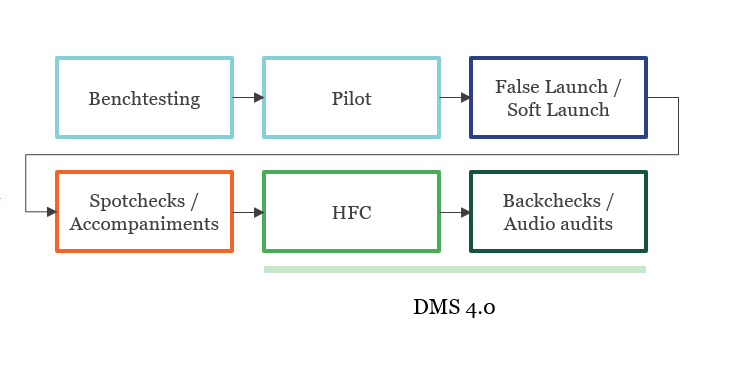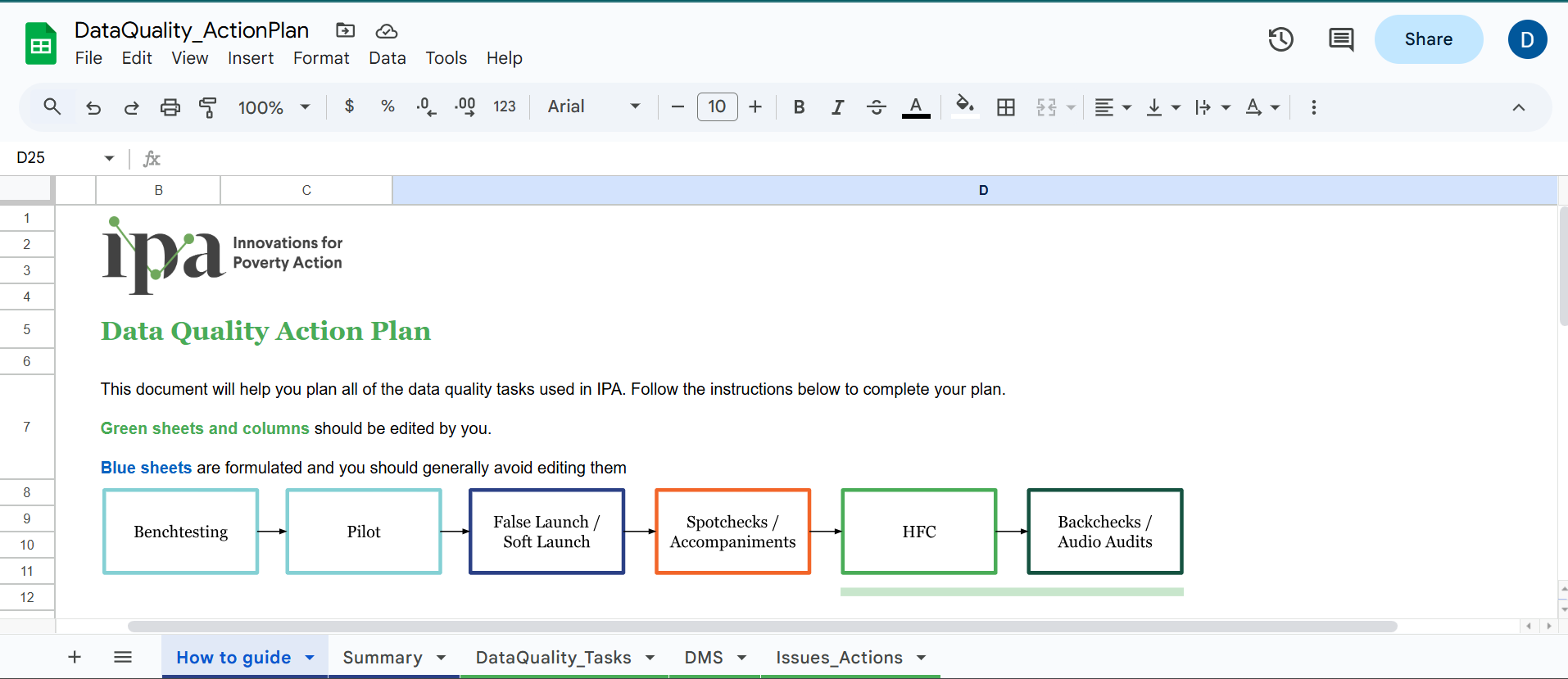Data Quality Action Plan
This guide outlines the Data Quality Action Plan, a tool designed to help IPA research staff systematically manage data quality throughout the data lifecycle.
- The DQAP provides a framework for planning, implementing, and acting on data quality checks, ensuring the effective use of the Data Management System (DMS four-point-zero) and other quality assurance measures.
- The DQAP enhances team collaboration by clearly defining roles and responsibilities for data quality management.
What is the Data Quality Action Plan?
Preparing for data collection often involves juggling multiple tasks, which can limit the ability of research staff to fully use tools like the DMS four-point-zero. The Data Quality Action Plan (DQAP) addresses this challenge by offering a structured framework for planning and executing data quality activities. It helps teams:
- Identify and resolve data quality issues.
- Maximize the use of the DMS four-point-zero.
- Enhance the actionability of data quality checks.
The DQAP focuses on eight core data quality tasks, each designed to address specific issues during data collection. This template serves as a centralized repository for planning and tracking these activities, ensuring a comprehensive approach to data quality management.

Purpose of the DQAP
The DQAP aims to establish a systematic approach to data quality management, with the following objectives:
- Facilitate Training and Tool Adoption: Provide clear guidelines for research staff to plan, program, and act on data quality checks.
- Enhance Actionability: Offer actionable insights and recommendations for addressing data quality issues.
- Boost Accountability: Clearly define roles and responsibilities for Principal Investigators (PIs), Research Managers, Research Associates, and Field Managers in data quality activities.
- Promote DMS Four-Point-Zero Use: Ensure teams leverage the full potential of the DMS four-point-zero in all IPA data collection initiatives.
The DQAP Tool
The DQAP tool is a Google Sheets template with five sheets, three of which require input: DataQuality_Tasks, DMS, and Issues and Actions.

The DQAP template is available to IPA staff on Box. You can access it using the following link: DQAP Template on Box.
If you are unable to access the file, contact Research Support at researchsupport@poverty-action.org.
Below is an overview of each sheet
This sheet provides step-by-step instructions for filling out the DQAP. It uses color-coding for clarity:
- Green: Fields that require editing.
- Blue: Fields that you should not modify.
This sheet summarizes the finalized DQAP for sharing with PIs, Research Managers, and Field Coordinators. It highlights the active tasks and checks, ensuring alignment and accountability across the team.
This sheet outlines the eight core data quality tasks shown in the figure above. It includes:
- Blue Columns (Pre-filled):
- Description: Explains each task.
- How Can This Activity Help?: Describes how the task identifies issues.
- What Does This Activity Require?: Lists prerequisites for implementation.
- Green Columns (Research staff complete these):
- Activity Active in This Project?: Checkbox to indicate if the task is in use.
- What Will the Project Check?: A brief description of the task’s purpose for the project.
- Resources: Links to manuals and guides for implementing each task.
This sheet details the checks available in the DMS four-point-zero. It includes:
- Pre-filled Columns:
- Global do-file section: Identifies the section of the do-file to modify.
- Input File/Sheet: Specifies the input files and sheets required.
- Output File/Sheet: Names the output files and sheets.
- Description: Explains the purpose of each check.
- How Can This Information Be Used?: Suggests potential uses for the output.
- Recommended Resources: Links to IPA resources.
- Green Columns (Research staff complete these):
- Check Active?: Checkbox to indicate if the check is in use.
- Survey Variables and Information for Checks: Lists variables or parameters needed for the check.
This sheet serves as a reference for identifying and resolving common data quality issues. It includes:
- Issues:
- Issue Descriptions: Describes potential data quality issues.
- Checks:
- Identifies the data quality activity or DMS output that can detect the issue.
- Actions:
- Programming Actions: Solutions for issues related to data management and cleaning.
- Field Protocol Actions: Recommendations for improving enumerator performance or field logistics.
- Person Responsible: Specifies the team member responsible for each action (editable).
How to Design a DQAP for Your Project
Follow these steps to create a tailored DQAP for your data collection initiative:
| Step | Description |
|---|---|
| 1 | Create a copy of the DQAP template in your project’s Box folder. Keep it as a Google Sheet to preserve conditional formatting. |
| 2 | Review and fill out the DataQuality_Tasks sheet. Mark the tasks you plan to use and describe what to check. |
| 3 | Review and fill out the DMS sheet. Activate relevant checks and specify the required variables. |
| 4 | Review the Issues and Actions sheet. Filter active checks and add or modify issues and actions as needed. |
| 5 | Assign responsibilities for each action in the Issues and Actions sheet based on your team’s structure. |
| 6 | Share the finalized DQAP with your team using the Summary sheet. Gather feedback to ensure alignment and accountability. |
| 7 | Begin programming your DMS based on the finalized plan. |
Conclusion
The Data Quality Action Plan is a powerful tool for ensuring high-quality data collection. By following this structured approach, research teams can proactively address data quality issues, maximize the use of the DMS four-point-zero, and ensure accountability across all stages of the data lifecycle.

